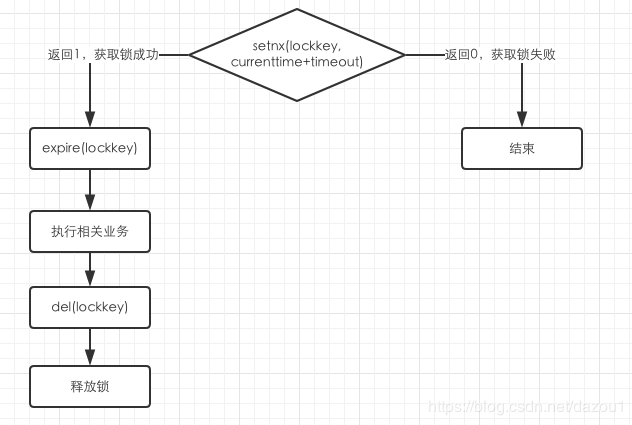SpringBoot 集成 redis 分布式锁
继上一篇 SpringBoot 整合 redis 踩坑日志之后,又学习了 redis 分布式锁,那为什么需要分布式锁?
redis 分布式锁原理
在传统单体应用单机部署的情况下,可以使用 Java 并发相关的锁,如 ReentrantLcok 或 synchronized 进行互斥控制。但是,随着业务发展的需要,原单体单机部署的系统,渐渐的被部署在多机器多JVM上同时提供服务,这使得原单机部署情况下的并发控制锁策略失效了,为了解决这个问题就需要一种跨JVM的互斥机制来控制共享资源的访问,这就是分布式锁要解决的问题。
分布式锁的实现条件
- 互斥性,和单体应用一样,要保证任意时刻,只能有一个客户端持有锁
- 可靠性,要保证系统的稳定性,不能产生死锁
- 一致性,要保证锁只能由加锁人解锁,不能产生A的加锁被B用户解锁的情况
分布式锁的实现
Redis 实现分布式锁不同的人可能有不同的实现逻辑,但是核心就是下面三个方法。
1.SETNXSETNX key val 当且仅当 key 不存在时,set 一个 key 为 val 的字符串,返回1;若 key存在,则什么都不做,返回0。
2.Expireexpire key timeout 为 key 设置一个超时时间,单位为second,超过这个时间锁会自动释放,避免死锁。
3.Deletedelete key 删除 key 。
原理图如下:

redis 分布式锁实战
项目代码结构图

导入依赖
在 pom.xml 中添加 starter-web、starter-aop、starter-data-redis 的依赖
<dependencies>
<dependency>
<groupId>org.springframework.boot</groupId>
<artifactId>spring-boot-starter-web</artifactId>
</dependency>
<dependency>
<groupId>org.springframework.boot</groupId>
<artifactId>spring-boot-starter-aop</artifactId>
</dependency>
<dependency>
<groupId>org.springframework.boot</groupId>
<artifactId>spring-boot-starter-data-redis</artifactId>
</dependency>
</dependencies>
复制代码
属性配置
在 application.properites 资源文件中添加 redis 相关的配置项
server:
port: 1999
spring:
datasource:
url: jdbc:mysql://127.0.0.1:3306/mybatis-plus-test?useUnicode=true&characterEncoding=UTF-8&useSSL=false&serverTimezone=Asia/Shanghai
driverClassName: com.mysql.cj.jdbc.Driver
username: root
password: root
redis:
host: 127.0.0.1
port: 6379
timeout: 5000ms
password:
database: 0
jedis:
pool:
max-active: 50
max-wait: 3000ms
max-idle: 20
min-idle: 2
复制代码
注解
1、创建一个 CacheLock 注解,属性配置如下
- prefix: 缓存中 key 的前缀
- expire: 过期时间,此处默认为 5 秒
- timeUnit: 超时单位,此处默认为秒
- delimiter: key 的分隔符,将不同参数值分割开来
package com.tuhu.twosample.chen.distributed.annotation;
import java.lang.annotation.*;
import java.util.concurrent.TimeUnit;
/**
* 锁的注解
* @author chendesheng
* @create 2019/10/11 16:06
*/
@Target({ElementType.METHOD})
@Retention(RetentionPolicy.RUNTIME)
@Documented
@Inherited
public @interface CacheLock {
/**
* redis 锁key的前缀
*
* @return redis 锁key的前缀
*/
String prefix() default "";
/**
* 过期秒数,默认为5秒
*
* @return 轮询锁的时间
*/
int expire() default 5;
/**
* 超时时间单位
*
* @return 秒
*/
TimeUnit timeUnit() default TimeUnit.SECONDS;
/**
* <p>Key的分隔符(默认 :)</p>
* <p>生成的Key:N:SO1008:500</p>
*
* @return String
*/
String delimiter() default ":";
}
复制代码
2、 key 的生成规则是自己定义的,如果通过表达式语法自己得去写解析规则还是比较麻烦的,所以依旧是用注解的方式
package com.tuhu.twosample.chen.distributed.annotation;
import java.lang.annotation.*;
/**
* 锁的参数
* @author chendesheng
* @create 2019/10/11 16:08
*/
@Target({ElementType.PARAMETER, ElementType.METHOD, ElementType.FIELD})
@Retention(RetentionPolicy.RUNTIME)
@Documented
@Inherited
public @interface CacheParam {
/**
* 字段名称
*
* @return String
*/
String name() default "";
}
复制代码
key生成策略
1、接口
package com.tuhu.twosample.chen.distributed.common;
import org.aspectj.lang.ProceedingJoinPoint;
/**
* key生成器
* @author chendesheng
* @create 2019/10/11 16:09
*/
public interface CacheKeyGenerator {
/**
* 获取AOP参数,生成指定缓存Key
*
* @param pjp PJP
* @return 缓存KEY
*/
String getLockKey(ProceedingJoinPoint pjp);
}
复制代码
2、接口实现
package com.tuhu.twosample.chen.distributed.common;
import com.tuhu.twosample.chen.distributed.annotation.CacheLock;
import com.tuhu.twosample.chen.distributed.annotation.CacheParam;
import org.aspectj.lang.ProceedingJoinPoint;
import org.aspectj.lang.reflect.MethodSignature;
import org.springframework.util.ReflectionUtils;
import org.springframework.util.StringUtils;
import java.lang.annotation.Annotation;
import java.lang.reflect.Field;
import java.lang.reflect.Method;
import java.lang.reflect.Parameter;
/**
* 通过接口注入的方式去写不同的生成规则
* @author chendesheng
* @create 2019/10/11 16:09
*/
public class LockKeyGenerator implements CacheKeyGenerator {
@Override
public String getLockKey(ProceedingJoinPoint pjp) {
MethodSignature signature = (MethodSignature) pjp.getSignature();
Method method = signature.getMethod();
CacheLock lockAnnotation = method.getAnnotation(CacheLock.class);
final Object[] args = pjp.getArgs();
final Parameter[] parameters = method.getParameters();
StringBuilder builder = new StringBuilder();
//默认解析方法里面带 CacheParam 注解的属性,如果没有尝试着解析实体对象中的
for (int i = 0; i < parameters.length; i++) {
final CacheParam annotation = parameters[i].getAnnotation(CacheParam.class);
if (annotation == null) {
continue;
}
builder.append(lockAnnotation.delimiter()).append(args[i]);
}
if (StringUtils.isEmpty(builder.toString())) {
final Annotation[][] parameterAnnotations = method.getParameterAnnotations();
for (int i = 0; i < parameterAnnotations.length; i++) {
final Object object = args[i];
final Field[] fields = object.getClass().getDeclaredFields();
for (Field field : fields) {
final CacheParam annotation = field.getAnnotation(CacheParam.class);
if (annotation == null) {
continue;
}
field.setAccessible(true);
builder.append(lockAnnotation.delimiter()).append(ReflectionUtils.getField(field, object));
}
}
}
return lockAnnotation.prefix() + builder.toString();
}
}
复制代码
Lock拦截器(AOP)
熟悉 Redis 的朋友都知道它是线程安全的,我们利用它的特性可以很轻松的实现一个分布式锁,如opsForValue().setIfAbsent(key,value)它的作用就是如果缓存中没有当前 Key 则进行缓存同时返回 true 反之亦然;当缓存后给 key 在设置个过期时间,防止因为系统崩溃而导致锁迟迟不释放形成死锁; 那么我们是不是可以这样认为当返回 true 我们认为它获取到锁了,在锁未释放的时候我们进行异常的抛出….
package com.tuhu.twosample.chen.distributed.interceptor;
import com.tuhu.twosample.chen.distributed.annotation.CacheLock;
import com.tuhu.twosample.chen.distributed.common.CacheKeyGenerator;
import org.aspectj.lang.ProceedingJoinPoint;
import org.aspectj.lang.annotation.Around;
import org.aspectj.lang.annotation.Aspect;
import org.aspectj.lang.reflect.MethodSignature;
import org.springframework.beans.factory.annotation.Autowired;
import org.springframework.context.annotation.Configuration;
import org.springframework.data.redis.core.StringRedisTemplate;
import org.springframework.util.StringUtils;
import java.lang.reflect.Method;
/**
* @author chendesheng
* @create 2019/10/11 16:11
*/
@Aspect
@Configuration
public class LockMethodInterceptor {
@Autowired
public LockMethodInterceptor(StringRedisTemplate lockRedisTemplate, CacheKeyGenerator cacheKeyGenerator) {
this.lockRedisTemplate = lockRedisTemplate;
this.cacheKeyGenerator = cacheKeyGenerator;
}
private final StringRedisTemplate lockRedisTemplate;
private final CacheKeyGenerator cacheKeyGenerator;
@Around("execution(public * *(..)) && @annotation(com.tuhu.twosample.chen.distributed.annotation.CacheLock)")
public Object interceptor(ProceedingJoinPoint pjp) {
MethodSignature signature = (MethodSignature) pjp.getSignature();
Method method = signature.getMethod();
CacheLock lock = method.getAnnotation(CacheLock.class);
if (StringUtils.isEmpty(lock.prefix())) {
throw new RuntimeException("lock key can't be null...");
}
final String lockKey = cacheKeyGenerator.getLockKey(pjp);
try {
//key不存在才能设置成功
final Boolean success = lockRedisTemplate.opsForValue().setIfAbsent(lockKey, "");
if (success) {
lockRedisTemplate.expire(lockKey, lock.expire(), lock.timeUnit());
} else {
//按理来说 我们应该抛出一个自定义的 CacheLockException 异常;
throw new RuntimeException("请勿重复请求");
}
try {
return pjp.proceed();
} catch (Throwable throwable) {
throw new RuntimeException("系统异常");
}
} finally {
//如果演示的话需要注释该代码;实际应该放开
// lockRedisTemplate.delete(lockKey);
}
}
}
复制代码
控制层
在接口方法上添加 @CacheLock(prefix = "test"),然后动态的值可以加上@CacheParam;生成后的新 key 将被缓存起来;(如:该接口 token = 1,那么最终的 key 值为 test:1,如果多个条件则依次类推)
package com.tuhu.twosample.chen.controller;
import com.tuhu.twosample.chen.distributed.annotation.CacheLock;
import com.tuhu.twosample.chen.distributed.annotation.CacheParam;
import lombok.extern.slf4j.Slf4j;
import org.springframework.web.bind.annotation.GetMapping;
import org.springframework.web.bind.annotation.RequestMapping;
import org.springframework.web.bind.annotation.RequestParam;
import org.springframework.web.bind.annotation.RestController;
/**
* @author chendesheng
* @create 2019/10/11 16:13
*/
@RestController
@RequestMapping("/chen/lock")
@Slf4j
public class LockController {
@CacheLock(prefix = "test")
@GetMapping("/test")
public String query(@CacheParam(name = "token") @RequestParam String token) {
return "success - " + token;
}
}
复制代码
主函数
需要注入前面定义好的 CacheKeyGenerator 接口具体实现 ….
package com.tuhu.twosample;
import com.tuhu.twosample.chen.distributed.common.CacheKeyGenerator;
import com.tuhu.twosample.chen.distributed.common.LockKeyGenerator;
import org.mybatis.spring.annotation.MapperScan;
import org.springframework.boot.SpringApplication;
import org.springframework.boot.autoconfigure.SpringBootApplication;
import org.springframework.context.annotation.Bean;
/**
* @author chendesheng
* @since 2019-08-06
*/
@SpringBootApplication
@MapperScan("com.baomidou.mybatisplus.samples.quickstart.mapper")
@MapperScan("com.tuhu.twosample.chen.mapper")
public class TwoSampleApplication {
public static void main(String[] args) {
SpringApplication.run(TwoSampleApplication.class, args);
}
@Bean
public CacheKeyGenerator cacheKeyGenerator() {
return new LockKeyGenerator();
}
}
复制代码
- 本文标签: 部署 db sql 注释 REST dist bean 一致性 并发 tab 安全 时间 value build kk springboot 缓存 ssl cat 代码 key dataSource ACE 分布式 JDBC root 线程 IDE XML final Word id synchronized web tar redis Document 锁 删除 AOP java https UI 解析 dependencies http IO JVM spring 配置 App 参数 core cache token 2019 mysql pom map CTO mybatis src mapper 分布式锁
- 版权声明: 本文为互联网转载文章,出处已在文章中说明(部分除外)。如果侵权,请联系本站长删除,谢谢。
- 本文海报: 生成海报一 生成海报二











![[HBLOG]公众号](http://www.liuhaihua.cn/img/qrcode_gzh.jpg)

